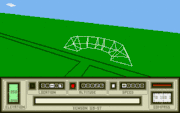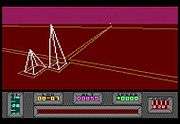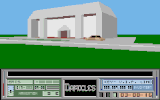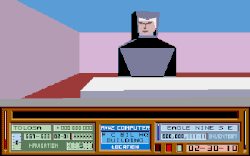Mercenary (video game)
Mercenary is the first in a series of computer games, published on a number of 8-bit and 16-bit platforms from the mid-1980s to the early 1990s, by Novagen Software. The second and third games were known as Damocles and Mercenary III: The Dion Crisis respectively.
| Mercenary | |
|---|---|
 Cover art | |
| Developer(s) | Novagen |
| Designer(s) | Paul Woakes Bruce Jordan |
| Artist(s) | Peter Gudynas |
| Platform(s) | Atari 8-bit (original) Commodore 64, ZX Spectrum, Amstrad CPC, Atari ST, Amiga, Commodore 16/116/Plus/4 |
| Release | 1985 |
| Genre(s) | Action-adventure |
| Mode(s) | Single player |
The games were notable for their smooth vector and polygonal graphics, vast environments, and open-ended gameplay which offered several ways to complete each game. All three titles were favourably reviewed when they were originally released,[1][2][3][4][5][6][7][8][9][10][11] and the titles have a following in the retrogaming community.[12]
Overview
The Mercenary series consists of three main games and a number of add-on datasets. While each game is self-contained, they make occasional references to other games in the series and are connected in terms of their freeform, open-ended gameplay, visual appearance and general ambience.
Within each game the player must explore a world rendered in realtime 3D graphics, completing a number of non-linear tasks in order to achieve a single main objective. The title of the series derives from the player's role in carrying out tasks as a "hired gun". In Mercenary the player crash lands into an ongoing conflict[13] and is able to play the warring factions off against one another to the player's own advantage. In Damocles the player is encouraged to bargain the fate of a whole world for financial reward. However, in The Dion Crisis the player has a less selfish agenda, and must gain the support of voters against the plotting of a sinister businessman.
In all three games, the player is accompanied and advised by Benson, a "9th generation PC". This interaction is handled via a scrolling news ticker at the bottom of the display. As well as providing assistance to the player, much of the humour within the games comes from the occasional sarcastic remarks made by Benson.[4]
The Mercenary series
Mercenary


Mercenary (also known as Mercenary: Escape from Targ, Mercenary 1, and Mercenary: A Flight Simulator Adventure in the US) is the first game in the series. It was initially released on the Atari 8-bit family in 1985 and later converted to the Commodore 64, ZX Spectrum, Amstrad CPC, Atari ST, Commodore Amiga and Commodore 16/116/Plus/4 platforms. Across all versions, the game environment is presented using wire frame graphics.
Having crash-landed on the planet Targ (en route to the Gamma System of Damocles), the player's main objective is to find a means of escape.[13] In a trademark element of the Mercenary series, there are several ways to achieve this end. A civil war between two factions, the Palyars (indigenous "good guys") and the Mechanoids (invading "bad guys"), affords the player an opportunity to earn money to buy their escape from Targ. For instance, each faction seeks the destruction of installations belonging to its rival, and the capture of material or other resources to support their cause. There are other routes to escape, and it is possible to combine strategies to both leave Targ and keep the wealth accrued there.
Mercenary: The Second City
Mercenary: The Second City, released in 1986, is an expansion pack for the original game. Initially its major distinction is the new colour scheme, representing the other side of the planet. The ground is now red rather than the original green, and the sky is no longer blue. Instead, it is pink in the Amiga and Atari (8-bit and ST) versions,[14][15] dark blue on the Commodore 8-bit platforms (C64 and Plus/4)[16][17] and yellow on the ZX Spectrum.[18]
However, after a similar objective, the substantive differences reveal themselves subtly: there is a more intricate underground complex, a new set of puzzles to overcome and several significant changes with game objects. It was later repackaged with the original game under the title Mercenary Compendium.[15]
Damocles
| Damocles | |
|---|---|
| Developer(s) | Novagen |
| Platform(s) | Atari ST, Amiga |
| Release | 1990 |
| Genre(s) | Action-adventure |
| Mode(s) | Single player |

Damocles (occasionally advertised as Mercenary II) is the second game in the series. It was released on the Atari ST and Amiga platforms in 1990. Commodore 64 and ZX Spectrum versions were originally in development but eventually cancelled as a consequence of the declining 8-bit market. Unlike Mercenary, Damocles represented the game environment using filled polygon graphics, allowing a both more realistic and colourful world. An improved, fully texture mapped IBM PC version was in an advanced stage of development and scheduled for release in 1995, but was ultimately cancelled when a conflict between its developers, Novagen and Psygnosis, arose.
Once again, the player is stranded on a planet, Eris, with an inoperable spacecraft. Unlike the first game, however, the scope of Damocles is considerably widened, offering the player an entire solar system to explore (the Gamma System; the player's original destination before the Interlude on Targ). There is also a race-against-time element to the game as a comet, the eponymous Damocles (a reference to the Sword of Damocles), is hurtling towards Eris. The player is encouraged to both escape Eris and find a means to prevent Damocles from destroying the planet, if possible without destroying the comet. Although an obvious, but destructive, solution exists, Damocles has no fewer than five distinct solutions.[19]
A notable feature of Damocles is its inclusion of orbital mechanics into the game physics. While also featuring less standard physics (e.g. teleportation), it includes a detailed representation of the dynamics of the Gamma System and even includes a simplified form of special relativity. To cross the solar system in reasonable (to the player) time, time dilation occurs. However, given that the player has only a few hours to save Eris, extended periods at near-light speed are unwise. One of the game's many solutions even involves manipulating various planetary bodies in order to make use of the changes in gravitational pulls to divert the Damocles comet. From an aesthetic point of view, the inclusion of celestial physics allows the player to experience attractively-rendered sunrises and sunsets while on planet surfaces as well as various satellite occultations.
Damocles contains many real-world references, particularly drawn from the UK in the 1980s. For example, the president of the planet Eris is named Margaret, after Margaret Thatcher (British Prime Minister from 1979 to 1990); and there is a bank called Lawson Bank, after Nigel Lawson (British chancellor of the exchequer from 1983 to 1989; though a real Lawson Bank does exist).[20] Some of the references are more elusive; for example, several stores are called "GUM Stores", after the real Russian Gosudarstvennyj Universalnyj Magazin department stores. However, the fictional planet of Eris is not a reference to the real-life dwarf planet of the same name, as the latter was only discovered in 2005, some 15 years after the release of Damocles.
Despite these references, the game universe has no actual connections with Earth, since the player is given information that the Gamma System was actively explored before the present day (e.g. on approaching a particular moon, Benson informs the player that a space flight company was already present there in 1190). According to the poster that accompanied the game, the events of Damocles take place on 27 April 2099.
Damocles: Mission Disks
Two mission disks for Damocles were released, known simply as Damocles: Mission Disk 1 and Damocles: Mission Disk 2 respectively. Each disk added a number of extra missions that could be loaded in as saved games, offering the player a few more tasks to complete within the game. Usually these tasks put the player in difficult or unusual situations from which they have to extricate themselves.
Mercenary III
| Mercenary III: The Dion Crisis | |
|---|---|
 Evil PC BIL | |
| Developer(s) | Novagen Software |
| Platform(s) | Atari ST, Commodore Amiga |
| Release | 1992 |
| Genre(s) | Action-adventure |
| Mode(s) | Single player |
Mercenary III (also known as Mercenary III: The Dion Crisis or Damocles II) is the third and final game in the series. It was released on the Atari ST and Amiga platforms in 1992. Mercenary III is set in the Gamma System again and is based on an improved version of the engine used by Damocles: this time the roads of the various cities are populated by vehicles such as taxis and buses; observation and attack spacecraft are present in the skies; and interaction (albeit to a limited degree) with other characters is possible.
After Eris' President Margaret steps down, the player becomes involved in a political crisis on the planet Dion, pitting their wits against a power-hungry politician running for president. The goal of Mercenary III is to prevent this politician from being elected to office. Similarly to the earlier titles, there are several ways of achieving this, with both straightforward and oblique solutions. No mission disks were released for this concluding chapter of the Mercenary series. According to the poster that accompanied the game, the events of Mercenary III take place on 15 January 2101.
The villain of this game is a character who appeared in Mercenary: PC BIL, short for the Palyars Commander's Brother-In-Law.
False sequel
In April 1998, the Italian gaming website Zzap! (managed by the same editors and in the same style of the Italian edition of Zzap!64) published a review of a nonexistent sequel as an April Fool's Day prank. The plot of this game, supposedly titled Mercenary IV: The Eleventh Planet, would have been about the invasion of the Gamma system by the inhabitants of a planet with an erratic orbit that entered the system once again.[21] In reality, the plot was inspired by Zecharia Sitchin's book The Twelfth Planet, while the images were doctored screenshots of a custom Duke Nukem 3D level and the unreleased PC version of Damocles.[22]
PC port
During the 2000s, the three games were ported to PC. It was distributed with the agreement of the former Novagen team.[23] The program, called MDDClone (Mercenary, Damocles, Dion crisis Clone) is freeware, includes all three games, selectable through a drop-down list. It features graphics and gameplay identical to that of the Atari ST versions of the games, with the additional option to fix some bugs that were originally present. To facilitate play, text in the games (principally that from Benson) has been translated from English into Danish, Dutch, French, German, Greek, Hungarian, Italian and Polish in the MDDClone.
Reception
| Mercenary reception | ||||||||||||
|---|---|---|---|---|---|---|---|---|---|---|---|---|
| ||||||||||||
| ||||||||||||
| Damocles reception | ||||||||||||
|---|---|---|---|---|---|---|---|---|---|---|---|---|
| ||||||||||||
| Mercenary III reception | ||||||||||||
|---|---|---|---|---|---|---|---|---|---|---|---|---|
| ||||||||||||
All three Mercenary titles received strong positive reviews from gaming magazines across all platforms, with the original Mercenary receiving a Gold Medal from Zzap!64 magazine.[2][25] RUN reviewer Bob Sodaro noted the replay value of Mercenary for the Commodore 64, writing "Prior to marking up the maps [included with the game], you should make a number of photocopies so you'll have clean copies when playing subsequent adventures".[24] Antic also advised making copies of the map and taking notes. It described the game's size and Atari 8-bit version's graphics as "awesome", but warned that a color display was required. The magazine concluded that "Mercenary's video effects make it a good game overall. But if you aren't in the right place to pick up the clues, you'll get nowhere".[28]
The ZX Spectrum version of Mercenary was voted number 15 in the Your Sinclair Readers' Top 100 Games of All Time,[29] while the Amiga version of Damocles was ranked the 21st best game of all time by Amiga Power.[30]
STart praised Damocles's "stunning graphics", and stated that the "massively-detailed environment ... is an innovation in game design". The magazine concluded that "Damocles is definitely a challenging race against time, to be tackled by all".[31]
References
- "Mercenary ZX Spectrum review". Crash (44). 1987.
- "Mercenary Commodore 64 review". Zzap!64 (11). 1986.
- "Mercenary Commodore Amiga review". CU Amiga. March 1988. Archived from the original on 2007-11-03.
- "Damocles Commodore Amiga review". CU Amiga. November 1989. Archived from the original on 2007-06-03.
- "Damocles Commodore Amiga review". Amiga Computing. 3. September 1990. Archived from the original on 2007-06-03.
- "Damocles Commodore Amiga review". Amiga Format (14). September 1990. Archived from the original on 2007-06-03.
- "Damocles Commodore Amiga review". Zzap!64 (59). March 1990.
- "Mercenary III Commodore Amiga review". CU Amiga. February 1992. Archived from the original on 2007-05-25.
- "Mercenary III Atari ST review". Amiga Computing. March 1992. Archived from the original on 2007-05-25.
- "Mercenary III Commodore Amiga review". Amiga Format (32). March 1992. Archived from the original on 2007-05-25.
- "Mercenary III Commodore Amiga review". Zero. March 1992. Archived from the original on 2007-05-25.
- The Mercenary Site, dedicated to all three installments of the Mercenary series
- Coles, Tony (15 June 2014). "Mercenary retrospective". Eurogamer. Retrieved 21 June 2019.
- "Atari 400 800 XL XE Mercenary – The Second City : scans, dump, download, screenshots, ads, videos, catalog, instructions, roms". Atarimania.com. 2012-11-29. Retrieved 2013-11-07.
- "Atari ST Mercenary – Compendium Edition : scans, dump, download, screenshots, ads, videos, catalog, instructions, roms". Atarimania.com. 2012-11-29. Retrieved 2013-11-07.
- "gamebase64.com – The Gamebase Collection". Gb64.com. Retrieved 2013-11-07.
- "Mercenary Compendium". Retrieved 2014-02-16.
- "Mercenary: The Second City". World of Spectrum. Retrieved 2013-11-07.
- Guyart, S.; Hurt, A.; Garycki, P.; Berry, S.; Sachs, M. (2004). "The Hitchhiker's Guide to Damocles: The five ways to win". The Mercenary Site. Retrieved 2009-06-23.
- "Lawson Bank". Lawson Bank. Retrieved 20 April 2018.
- "Fake Italian Mercenary 4 review" (in Italian). Xenia Edizioni. Retrieved 2011-02-25.
- "Making of the Mercenary 4 prank" (in Italian). Simone Gremmo. Retrieved 2011-02-25.
- "Mercenary site, MDDClone section". Simon Guyart. Retrieved 2011-02-25.
- Sodaro, Bob (April 1987). "Mercenary review". RUN. Peterborough, NH: CW Communications/Peterborough. 4 (4): 24. ISSN 0741-4285. OCLC 10151803.
- "The Zzap!64 ratings and labels". Zzap!64.
- "Damocles review from Amiga Computing Vol 3 No 4 (Sep 1990) – Amiga Magazine Rack". Amr.abime.net. Retrieved 2013-11-07.
- "Mercenary 3: The Dion Crisis review from CU Amiga (Feb 1992) – Amiga Magazine Rack". Amr.abime.net. Retrieved 2013-11-07.
- Pearlman, Gregg (April 1987). "Mercenary". Antic.
- "Readers' Top 100 Games of All Time". Your Sinclair. September 1993.
- Amiga Power magazine issue 0, Future Publishing, May 1991
- Perez, Greg (February–March 1991). "For The Fun Of It". STart.